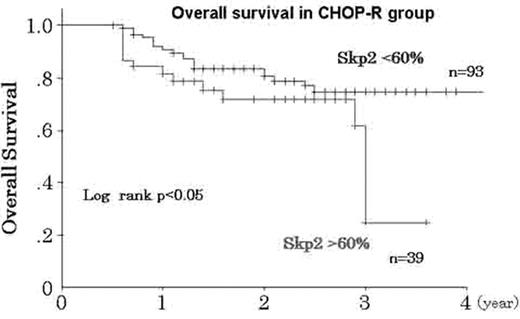Abstract
The addition of rituximab to CHOP (CHOP-R) chemotherapy has resulted in an improved outcome for patients with DLBCL and has recently been shown to diminish the prognostic impact of several recognized biomarkers. S-phase kinase-associated protein 2 (Skp2) is a proto-oncogene that has been shown to be expressed in a number of tumors. We have reported that Skp2 expression in tumor cells is an unfavorable prognostic factor in DLBCL. In the present study, we investigated the significance of Skp2 expression in the patients with DLBCL treated with CHOP or CHOP-R. DLBCL patients (333 cases) were entered into this study, based on the availability of paraffin blocks for interpretable immunohistochemistry for all antigens (CD10, Bcl-6, MUM1, Bcl-2, Skp2). All patients were treated with either CHOP (201) or CHOP-R (132) from 1996 to 2005, and were diagnosed as having DLBCL at the twenty different hospitals. All specimens were histopathologically reviewed before entering into this study. Their clinical characteristics, including either the IPI or R-IPI factors, were evenly matched. The median follow-up of living patients was 3.7 and 2.1 y for CHOP vs CHOP-R, respectively. DLBCL were assigned to GCB subtype (40.8%: 136/333) or non-GCB subtype (59.2%: 197/333) based on the method of Hans et al., Blood 103: 275–82 (2004), with similar distribution in both treatment groups. Expression of bcl-6 (p<0.05) or GCB subtypes (p<0.05) was associated with better overall survival (OS), whereas expression of bcl-2 (p<0.05) was associated with worse OS in CHOP treatment group. The addition of R was associated with an improved survival in the non-GCB subtype and resulted in same as that of GCB subtype. The survival benefit of both low Bcl-2 and high Bcl-6 expressions diminished in combined treatment with R to CHOP. There were 97 patients with high Skp2 expression (>60% positive cells) (97/333: 29.1%). High Skp2 expression was found in both GCB subtype (28.6%) and non-GCB subtype (30.3%). In advanced clinical stage or extranodal involvement (>2), the patients with high Skp2 expression had worse survival than those with low Skp2 expression (p<0.05). Interestingly, in CHOP-R group, high Skp2 expression was the strong biomarker of worse prognosis (p<0.05). DLBCL patients with high Skp2 expression did not benefit from the addition of R to CHOP. Therefore, Skp2 may be a useful prognostic marker in recent rituximab era. The new treatment strategy is necessary for the DLBCL patients with high Skp2 expression.
Author notes
Disclosure: No relevant conflicts of interest to declare.


This feature is available to Subscribers Only
Sign In or Create an Account Close Modal